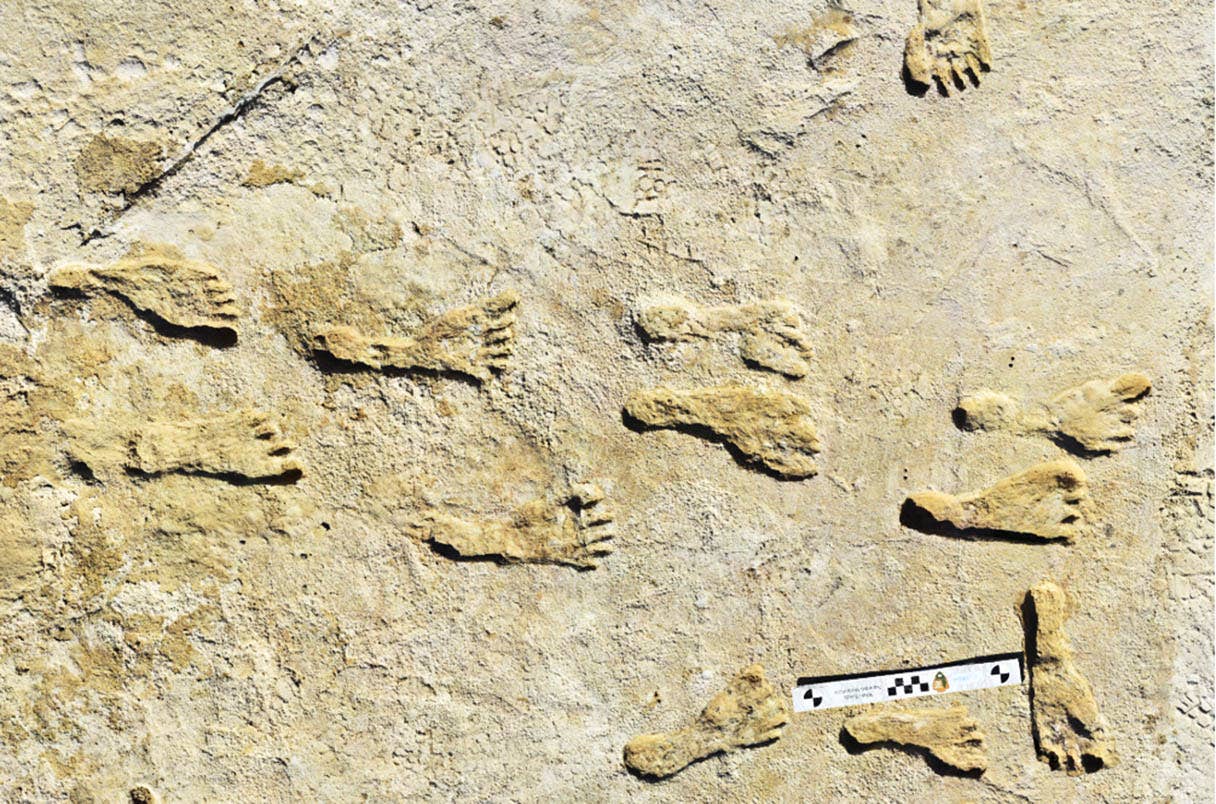23,000-Year-Old Footprints Discovered in New Mexico Rewrite Human History in America
23,000-year-old footprints in New Mexico reveal humans reached North America 10,000 years earlier than once believed.

Footprints preserved in New Mexico’s White Sands reveal humans lived in North America 23,000 years ago—much earlier than experts once believed. (CREDIT: National Park Service)
Beneath the white gypsum dunes of New Mexico, scientists have uncovered something remarkable—trails of footprints that challenge what we thought we knew about early humans in North America. These prints, preserved in hardened mud at White Sands National Park, have now been confidently dated to around 23,000 years ago. That’s 10,000 years earlier than previous estimates of when humans first set foot on this continent.
For decades, researchers believed humans arrived in the Americas about 13,000 years ago. But these ancient tracks push that timeline back to the height of the Last Glacial Maximum—a time when much of the world was covered in ice. With each new piece of evidence, the story of early migration is changing.
Tracing the Steps of the First Americans
The initial discovery in 2021 was groundbreaking. A team of scientists, led by the U.S. Geological Survey, used radiocarbon dating on seeds of common ditch grass found within the same sediment layers as the footprints. These seeds provided the first estimate of the footprints’ age—about 23,000 years. But because that method can be affected by hard water minerals, other scientists challenged the results.
So, the research team returned to the site. This time, they used a more advanced technique: radiocarbon dating of fossilized pollen, extracted using a method known as flow cytometry. Pollen cells, especially pine pollen, are more resistant to contamination. Since these pollen grains were found in the same mud layer as the footprints and showed no sign of hard water interference, they provided independent confirmation of the original dating.
“We were pleased that our original work was discussed and tested by the scientific community,” said Matthew Bennett, a professor and co-author of the study. “We are equally delighted that these new results underline the accuracy of our original study and provide a fascinating update to the movements and lifestyles of our ancestors.”
Three Dating Methods, One Clear Result
To make the case even stronger, researchers used a third technique: optically stimulated luminescence. This method checks the last time quartz grains were exposed to sunlight. The more trapped energy inside the grains, the older the layer. When the team exposed the quartz to light in the lab, the energy levels pointed once again to a date of around 23,000 years.
Related Stories
The fact that all three methods—grass seed dating, fossilized pollen dating, and luminescence—gave the same age added major weight to the findings. These techniques confirmed that humans were in North America during the Last Glacial Maximum, long before ice-free corridors opened across the continent.
“These findings have underlined our timeline and given proof that human activity took place in the Americas long before we previously thought,” said Dr. Sally Reynolds, a paleoecologist on the team. “We’re looking forward to unearthing more secrets about how our ancestors lived.”
The research, published in the journal Science, is the result of collaboration between scientists from Bournemouth University, the U.S. Geological Survey, the National Park Service, Cornell University, and the University of Arizona.
A Glimpse Into Prehistoric Life
While the age of the footprints is significant, what they reveal about early human behavior may be even more powerful.
According to Smithsonian Magazine and the research team, the footprints tell stories. Some show children playing near shallow puddles. Others follow the paths of large animals like giant sloths, suggesting hunters were tracking them. One set of prints, thought to belong to a young woman, shows her carrying a child—and slipping in the mud, possibly while fleeing from danger.
“There were hungry predators around, including dire wolves and saber-toothed cats,” said Bennett. “We can see where she slipped in the mud at certain points. We can also see the child’s footprints where she set it down, presumably because she was tired and needed a rest.”
These aren’t just fossilized steps—they’re records of daily life. They show interactions between adults, teenagers, and young children. Some of the prints are visible to the naked eye, while others had to be located with ground-penetrating radar. Each discovery adds another layer to our understanding of early communities in North America.
“The footprints left at White Sands give a picture of what was taking place—teenagers interacting with younger children and adults,” said Bennett. “We can think of our ancestors as quite functional, hunting, and surviving, but what we see here is also activity of play, and of different ages coming together. A true insight into these early people.”
A New Chapter in Human Migration
This research doesn’t just change a date in a textbook—it rewrites the story of how and when humans arrived in the Americas. For years, most scientists believed humans crossed the Bering Land Bridge from Asia during a brief period when ice sheets had retreated enough to allow passage. That window was thought to open about 13,000 years ago.
But the White Sands footprints show that humans were already far south of the Bering region 10,000 years earlier. This forces researchers to rethink theories about ancient migration routes. Were there earlier coastal paths used before the inland routes opened? Did small groups move through less frozen corridors, or possibly even arrive by boat?
With such a wide gap now revealed between previous estimates and new evidence, scientists are eager to explore what happened during those missing 10,000 years. How did people survive in such a cold and harsh world? What tools did they use? What did they eat? And how did their cultures evolve in such early conditions?
Dr. Reynolds emphasized that more research is needed to answer those questions. “Further work can now be done to understand how humans moved through this landscape, what they were doing, and how science can illuminate the missing 10,000 years we now know humans existed in the Americas,” she said.
The White Sands site may just be the beginning. With newer technologies like ground-penetrating radar and luminescence dating, more ancient footprints—and more surprises—could soon be found elsewhere across the continent.
Leaving Their Mark
These fossilized prints do more than prove that humans were here early. They show that life—full of challenges, play, danger, and community—was already thriving thousands of years before anyone expected.
White Sands National Park is now seen as one of the most archaeologically rich regions in North America. The dunes hold not just footprints, but stories—of a mother carrying her child, of children splashing near water, of hunters following prey. Each step preserved in the mud offers a rare and personal connection to the lives of people long gone.
“The site in New Mexico has rewritten history books,” said Reynolds. “These footprints provide a valuable window into the lives our ancestors lived and how much they were like us.”
As scientists continue to dig deeper, more secrets of these early Americans are likely to emerge. And with them, a clearer picture of how humanity first took root in a frozen land—and left its mark, one footprint at a time.
Note: The article above provided above by The Brighter Side of News.
Like these kind of feel good stories? Get The Brighter Side of News' newsletter.
Rebecca Shavit
Science & Technology Journalist | Innovation Storyteller
Based in Los Angeles, Rebecca Shavit is a dedicated science and technology journalist who writes for The Brighter Side of News, an online publication committed to highlighting positive and transformative stories from around the world. With a passion for uncovering groundbreaking discoveries and innovations, she brings to light the scientific advancements shaping a better future. Her reporting spans a wide range of topics, from cutting-edge medical breakthroughs and artificial intelligence to green technology and space exploration. With a keen ability to translate complex concepts into engaging and accessible stories, she makes science and innovation relatable to a broad audience.



